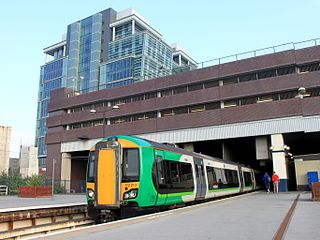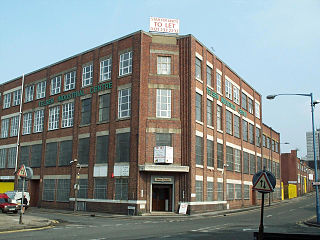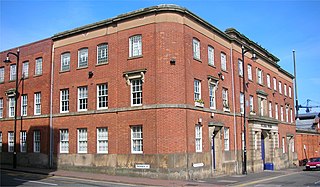
Birmingham Snow Hill is a railway station in Birmingham City Centre, England. It is one of the three main city-centre stations in Birmingham along with Birmingham New Street and Birmingham Moor Street.

A dip pen or nib pen usually consists of a metal nib with capillary channels like those of fountain pen nibs, mounted in a handle or holder, often made of wood. Other materials can be used for the holder, including bone, metal, and plastic; some pens are made entirely of glass. Generally, dip pens have no ink reservoir, so the user must recharge the ink from an ink bowl or bottle to continue drawing or writing. There are simple, tiny tubular reservoirs that illustrators sometimes clip onto dip pens, which allow drawing for several minutes without recharging the nib. Recharging can be done by dipping into an inkwell, but it is also possible to charge the pen with an eyedropper, a syringe, or a brush, which gives more control over the amount of ink applied. Thus, "dip pens" are not necessarily dipped; many illustrators call them "nib pens".

Smethwick is an industrial town in Sandwell, West Midlands, historically in Staffordshire. It is 4 miles west of Birmingham city centre and borders West Bromwich and Oldbury to the north and west. Formerly a Staffordshire county borough, Smethwick is situated near the edge of Sandwell metropolitan borough and borders the Birmingham districts of Handsworth, Winson Green, Harborne, Edgbaston and Quinton to the south and east, as well as the Black Country towns of West Bromwich and Oldbury in the north and west.

Birmingham Museum and Art Gallery (BM&AG) is a museum and art gallery in Birmingham, England. It has a collection of international importance covering fine art, ceramics, metalwork, jewellery, natural history, archaeology, ethnography, local history and industrial history.

The West Midlands is one of nine official regions of England at the first level of NUTS for statistical purposes. It covers the western half of the area traditionally known as the Midlands. It contains Birmingham and the larger West Midlands conurbation, which is the third most populous in the United Kingdom. The City of Coventry is also located within the West Midlands county, but is separated from the conurbation to the west by several miles of green belt. The region also contains 6 shire counties which stretch from the Welsh Border to the East Midlands.

The Custard Factory is an independent shopping destination and creative and digital business workspace location in Deritend Birmingham, England.

Mailbox Birmingham is an upmarket shopping and office development in the city centre of Birmingham, England. It serves as the base for BBC Birmingham and houses one of seven Harvey Nichols department stores in the United Kingdom.

Jewellery Quarter station is a combined railway station and tram stop, situated in the Jewellery Quarter of Birmingham, England. The station is served by West Midlands Trains, Chiltern Railways, and Midland Metro.

The Big City Plan is a major development plan for the city centre of Birmingham, England.

The Jewellery Quarter is an area of central Birmingham, UK. Situated in the north western area of Birmingham City Centre, there is a population of around 19,000 people in a 1.07-square-kilometre (264-acre) area.

Witton is an inner city area in Birmingham, England, in the metropolitan county of the West Midlands. It was within the ancient parish of Aston in the Hemlingford hundred of the historic county of Warwickshire. It is probably best known as the home of Aston Villa Football Club at Villa Park.
The Birmingham pen trade evolved in the Birmingham Jewellery Quarter and its surrounding area in the 19th century; for many years, the city was the centre of the world's pen trade, with most dip pens being produced there. At the height of the Jewellery Quarter's operations, there were about 100 pen factories, which employed around 8,000 skilled craftspeople.

Icknield Street School, near the Hockley Flyover, north of the Jewellery Quarter, Birmingham, England, is a good example of a Birmingham board school.

Associated Architects is a leading architectural firm based in Birmingham, England. The practice has a broad portfolio of work including arts, commercial offices, residential, masterplanning and leisure and is particularly known for its work in education. It has received many national awards including 30 RIBA Awards, together with the RIBA Sustainability Award. The practice recently completed the Centre for Medicine, at the University of Leicester which is currently the largest non-domestic building in the UK to be Passivhaus accredited.

Telsen Electric Company was a British electronics company formed in Birmingham in 1924 by Mr. A. Macnamara at 207 Aston Road.

Birmingham is a major city and metropolitan borough in the West Midlands, England. It is the second-largest city and metropolitan area in England and the United Kingdom, with roughly 1.1 million inhabitants within the city area and 4.3 million inhabitants within the metropolitan area. Birmingham is commonly referred to as the second city of the United Kingdom.
Birmingham city centre, also known as Central Birmingham and often known locally as town, is the central business district of Birmingham, England. Following the removal of the Inner Ring Road, the city centre is now defined as being the area within the Middle Ring Road. The city centre is undergoing massive redevelopment with the Big City Plan, which means there are now nine emerging districts and the city centre is approximately five times bigger.

Newman Brothers at The Coffin Works is a museum in the Newman Brothers Coffin Furniture Factory building in the Jewellery Quarter conservation area in Birmingham, England. The museum educates visitors about the social and industrial history of the site, which operated from 1894–1998 as a coffin furniture factory. The museum opened in October 2014 after a fifteen-year campaign by the Birmingham Conservation Trust to save the factory building, which ceased trading in 1998, and raise the funds to transform it into a heritage attraction. Located at 13–15 Fleet Street, the building is Grade II* listed.

The Pen Museum is a museum in Birmingham, England, United Kingdom dedicated to educating visitors about the history of Birmingham's steel pen trade. The only museum in the United Kingdom devoted to the history of the pen making industry, the Pen Museum explains how Birmingham became the centre of the world pen trade.

The Victoria Works is a Grade II listed building in the Jewellery Quarter of Birmingham, England. It was built in 1839–40 for Joseph Gillott, who manufactured pen nibs, and was one of the first purpose-built factories in the Jewellery Quarter. It is situated opposite the Argent Centre, another building constructed for industrial use around the same period. The factory was one of the largest of its kind, with nearly 600 workers. Steam engines of 60 horsepower powered the mass production of the nibs.


















